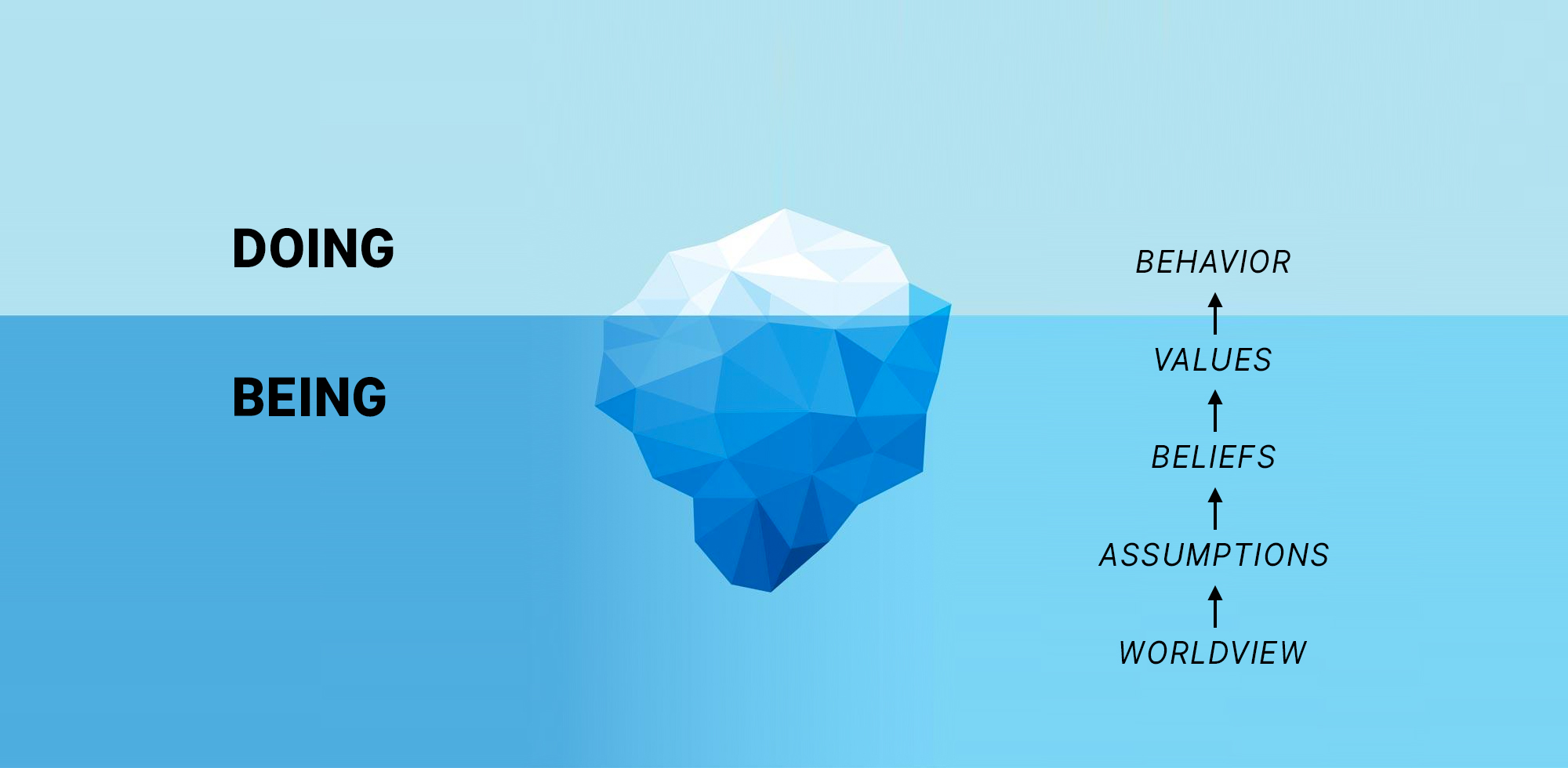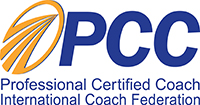We want to achieve goals, to lead better, to reach further. We want to improve.
These are noble intentions. The desire to learn and grow is a hallmark of high-impact people. Change is the name of the game.
Despite these strong urges, we often don’t succeed. We try to change, but it never seems to stick. We give up for a while, and then we try again six months later. We try, we give up, we try, we give up. It becomes a never-ending loop of trying to change, but not actually changing.
The reason change is so difficult is that we’re missing a crucial element: the foundation for change to take place upon.
The iceberg of doing and being
In coaching, there is a distinction between doing and being.
Doing is what you do. It’s the actions you take. It’s the decisions you make. It’s your behavior and all its visible manifestations.
Being is who you are. It’s what’s underneath all of the doing. It’s your qualities, your thought patterns, and your conditioning. It’s the pattern of beliefs that you hold about yourself and your environment. It’s your worldview.

When we set out to make a change, we usually attempt it on the doing level. We try to do new things, or we try to do things differently. But in most cases, we haven’t updated the being level. So what ends up happening is that we revert to our old defaults. The change doesn’t stick.
It’s like constructing a building on a wobbly foundation. Or like trying to stick a magnet to a fridge that’s built entirely of wood. It’s bound to fail.
Your assumptions of how the world works, your beliefs about what’s right and wrong…all of these determine what you do in the world. Your worldview is your incentive structure for action. It’s your embodied rulebook for life.
And so you can either try to break your own rules…or you can rewrite your rulebook entirely and play a different game.
You can address your doing, or you can address your being.
Examples of change from doing vs being levels
Here’s a few examples of the difference between the two levels of change.
Let’s say you want to be more organized. You feel like you don’t have an overview of what’s going on, so you want more structure and more consistency.
To solve the problem, you could change what you do — by setting up structures for your finances, adding systems and processes for marketing, and writing fancy labels on your folders.
But the truth is that you can organize until the world ends, and you’d still never feel like you’re organized enough. Your worldview is based on the assumption that uncertainty is dangerous. So what you really want is a sense of control and a feeling of certainty. What you really want is to know that things will work out, that they’ll be OK. What you really want is to know that you are OK, in a ceaselessly changing world that keeps reminding you that you are never quite enough.
The doing problem is organization. The being problem is dealing with uncertainty.
Perhaps you want to delegate more. You find yourself sticking your nose into everything, doing far more than you should as a leader. You’re becoming busier and busier, and your overflowing calendar is telling you it’s time to take a step back and let others take more responsibility.
The doing solution is to recruit more people. “If only I had more people, then I could delegate more”, you tell yourself.
But you can hire an army and delegate all you want—it will never be enough. Underneath it all you feel like your self-worth is solely based on what you do. You need to do as much as you can, to prove your own value to yourself and to others. A voice deep down asks you, in more words or less, “if I’m not busy taking care of everything, then who am I?” So you stick your nose into every task under the sun, proving to yourself that you are needed. That you are worthy.
The doing problem is delegating. The being problem is a subconscious need to prove your self-worth.
Or maybe you want to be more relaxed and less stressed. You feel like you’re running around at 200 kmh. Your head is exploding with ideas, to-dos, and next steps. You can’t just chill out — and you’re not sure you even want to. You’re always in motion, but now you can sense that you’re approaching the breaking point.
The immediate doing solution is to meditate, journal, and do yoga. To chill out.
But you can try to chill out all you want. You’ll always have the nagging sensation that you should be doing more, something more productive. That’s because below the surface, your sense of identity is tied up with productivity. In an attempt to shield your inner-most sensitive self from the world (and yourself), you’ve created a shell that’s all about action, struggle and movement. And so you feel like you have to prove yourself in every situation that you face. But deep down you’re scared of what you’ll find if you stop to take a breath; you’re resentful of what you’ll see in the mirror when you allow yourself to feel what you really feel. That fear then shows up as guilt when you’re not working hard. So to avoid that guilt, you struggle forward like your life depends on it.
The doing problem is stress, fatigue and burnout. The being problem is an unconscious need to struggle.
The being solution to all of these examples is quite simple: 1) To figure out what’s important to you and what you’re about. 2) To be OK with who you are right now. To be OK with not knowing the future. To be OK with not moving fast. To be OK with not always struggling ahead.
Simple, but not easy, I’ll admit.
Conclusion
The being level might seem trickier and scarier, but it’s also where robust, sustainable change is created. And the beauty is that if you address the being level, then the doing level takes care of itself. It will almost seem like magic.
This goes for individuals as it does for organizations. To make organizational change stick, you need a new set of assumptions. You need a new worldview. You need new mental models and new rulebooks to live, think and breathe by. You need to update the “organizational being” itself.
Whether it’s you or your company, it takes guts to address the being level. And it’s tough work to do alone, because these assumptions are so deeply ingrained that you’re blind to them at first. A coach, mentor or sparring partner can help to shine light on your own rulebook, and open your eyes to the beliefs and accepted truths that drive your behavior.
“We, human beings, live with a lot of answers to questions that we never ask,” says Julio Olalla. “What about asking those questions all over again?”
That’s what being work is. It’s asking yourself the big questions all over again.
What answers are you taking for granted in the world? What if you asked yourself those questions all over again? What would happen if you saw the world through a different lens, and a different set of assumptions?
“Today I escaped from the crush of circumstances,“ Marcus Aurelius once declared, “or better put, I threw them out, for the crush wasn’t from outside me but in my own assumptions.”
If you don’t change your worldview, your world won’t change.
So crush your own assumptions to escape the crush of circumstances.
Address your being, and let the doing flow from there.
